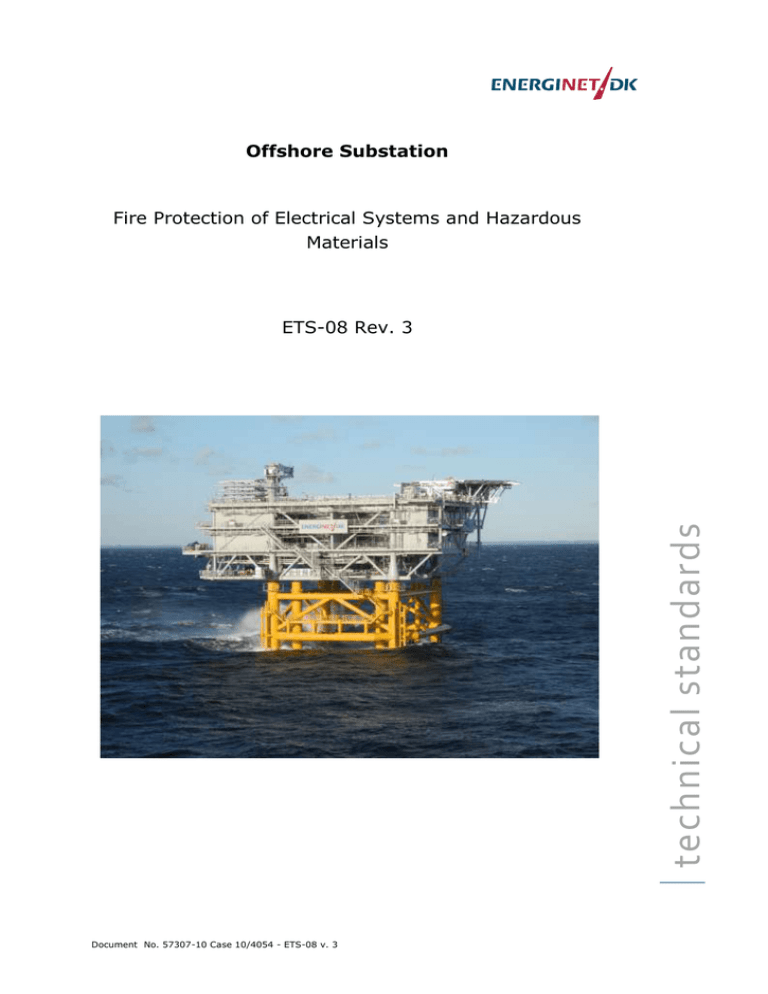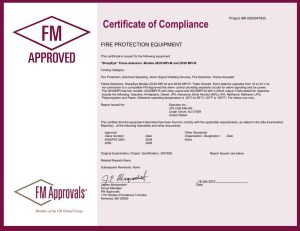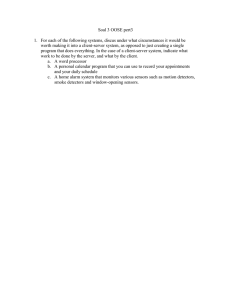08 A Fire Protection Elec.Systems and Hazardous
advertisement

Offshore Substation Fire Protection of Electrical Systems and Hazardous Materials technical standards ETS-08 Rev. 3 Document No. 57307-10 Case 10/4054 - ETS-08 v. 3 Revision survey Document title Fire Protection of Electrical Systems and Hazardous Materials Document no. 57307-10 Target group Fabrications Contractors and Designer for Offshore substations. Revision 1 2 3 Document status Approved Approved after review Approved Writer Init N/A N/A xomo Reviewer Date Init 12.10.09 N/A N/A 17.11.10 Date 12.10.09 17.11.10 POB, POD, 18.09.12 TKL, TAN, SGH, XBOH 18.09.12 Appendix no. and description None Document No. 57307-10 Case 10/4054 - ETS-08 v. 3 Approver Init AGS Date 12.10.09 SGH 17.11.10 SGH 18.09.12 Revision Table of contents 1. Scope 4 2.1 2.2 References Statutory Regulations Codes and Standards 4 4 4 3.1 3.2 Definitions and Abbreviations Definitions Abbreviations 4 4 5 2. 3. 4. 5. Technical Requirements 4.1 General 4.2 Fire and safety philosophy 4.3 Fire integrity of wall and decks separating adjacent spaces 4.4 Fire detection and alarms 4.4.1 Fire detection 4.4.2 Fire alarms 4.5 Active fire protection 4.5.1 Indoor areas 4.5.2 Outside areas 4.6 Passive fire protection Certificates / data books Document No. 57307-10 Case 10/4054 - ETS-08 v. 3 5 5 5 5 6 6 7 8 8 8 9 9 1. Scope This technical standard specifies the basic requirements for Fire protection of Electrical systems and Hazardous Materials to be used on an offshore located transformer platform (Substation) for offshore wind farms. 2. References 2.1 Statutory Regulations 2.2 2004/108/EC 89/106/EEC EMC directive The Construction Products Directive Codes and Standards DS/EN 54 series DS/CEN/TS 54-14 NFPA 72 NFPA 2001 Fire detection and fire alarm systems Fire detection and fire alarm systems: Guidelines for planning, design, installation, commissioning, use and maintenance National Fire Alarm Code Clean agent fire extinguishing systems DNV-OS-J201 Offshore Substations for Wind Farms 3. Definitions and Abbreviations 3.1 Definitions Shall: Verbal form used to indicate requirements to be strictly followed in order to conform to the standard and from which no deviation is permitted, unless accepted by all parties. Should: Verbal form used to indicate that among several possibilities one is recommended as particularly suitable, without mentioning or excluding others, or that a certain course of action is preferred but not necessarily required. May: Verbal form used to indicate a course of action permissible within the limits of the standard. Can: Verbal form used for statements of possibility and capability, whether material, physical or casual. Document No. 57307-10 Case 10/4054 - ETS-08 v. 3 4/9 3.2 Abbreviations N/A 4. 4.1 Technical Requirements General Fire detection and fire fighting shall as a minimum be designed and installed in accordance recommendations in DS/EN 54 series “Fire detection and alarm systems” concerning fire detection and installation and NFPA 2001 concerning extinguishing in rooms. In addition references are made to DNV offshore standard DNV-OS-J201 "Offshore substations for wind farms" in regards to fire detection system coverage and coverage of automatic fire protection equipment. In addition to the above guidelines and recommendations the most important requirements for the fire detection and fire fighting systems are to protect platform and equipment from damage caused by a fire, or to reduce the damages as much as possible. 4.2 Fire and safety philosophy The fire fighting philosophy on an Energinet.dk transformer platform must be to prevent fire from escalating via the use of good engineering practice during the design phase. In the case of an outbreak of fire on the platform automated fire fighting systems must be in place to extinguish the fire, said systems must be designed to avoid damage to electrical systems where possible. Escape options must be present on the platform to evacuate personnel currently on the platform; this will take form as MOB Boats and life rafts. When personnel are present on the platform they must have the ability to help extinguish or limit the fire. Fire fighting equipment must be present in all rooms and outdoors at strategic locations. In locations containing electrical equipment fire fighting equipment that does not destroy the electrical components must be present as well as regular fire fighting equipment. 4.3 Fire integrity of wall and decks separating adjacent spaces All areas on the platform shall be categorized in accordance with the requirements stipulated in DNV-OS-J201. Based on this study the minimum requirements for fire walls and decks shall be determined. Document No. 57307-10 Case 10/4054 - ETS-08 v. 3 5/9 4.4 Fire detection and alarms 4.4.1 Fire detection The platform shall have one automatic fire detection and alarm system (ABA automatisk brand alarmerings system). The specification of the ABA control unit is integrated in the Technical standard for SCADA and communication. A number of different types of detectors shall be used for fire detection depending of the type of area and equipment to be monitored. In rooms with inert gas coverage, smoke detectors shall be installed in groups of 3 in all closed areas such as switchgear rooms, auxiliary transformer rooms and equipment rooms. Smoke detectors shall also be installed underneath raised floors, above suspended ceilings and in voids used for cable distribution. Smoke detectors are not to be used in outdoor installations. The smoke detectors shall comply with the requirements of DS/EN 54-7 and DS/EN 54-12. The sensor is to be of the ionisation or optical type. The smoke detectors shall be installed with spacing as per the recommendations in DNV-OS-J201. After installation of smoke detectors a test under varying conditions shall be carried out. In areas such as, on site standby diesel generator room, workshop etc. where it is expected that smoke detection due to surrounding air can cause false alarms under normal conditions, heat detectors shall be installed in groups of 3. The heat detectors shall comply with the requirements of DS/EN 54-5. Examples of heat detectors: Fixed point Compensated point Rate of rise Fixed and compensated point detectors will respond when the sensing elements is heated to a predetermined level and are usually used in areas with no heat sources. Rate of rise will respond when the sensing element is heated to a predetermined rate of temperature rise and are usually used in areas with heat sources. The heat detectors shall be installed with spacing as per the recommendations in DNV-OS-J201. Document No. 57307-10 Case 10/4054 - ETS-08 v. 3 6/9 Flame detectors shall be used in outdoor areas such as the main transformers area and diesel storage tank. The flame detectors shall comply with the requirements of DS/EN 54-10. Examples of flame detectors: Ultra violet Infra red The detector spacing is based on vendor information and field view with respect to obstructions. Manual fire alarm call points shall be located at access/escape routes where there is no coverage from manual release points for inert gas or deluge. The manual call points shall comply with the requirements of DS/EN 54-11. Manual release push button for the release of inert gas shall be located outside rooms covered by inert gas. Manual release push button for the release of deluge shall be located in, or near to areas covered by deluge. For the main transformers manual release push buttons are to be installed on the main deck. Red push buttons are used for activating of alarms, and yellow push buttons are used for release of deluge/inert gas. All detector loops are to be with loop surveillance from the ABA system. Detectors of different detection principles can be mixed in the same loops, to limit the number of required loops needed. 4.4.2 Fire alarms If the platform is equipped with a public address (PA) system this shall be used for the audible alarms. Alarm sounders shall be located throughout the platform to ensure that they will be heard at all locations indoor and outdoor. The general fire alarm shall sound when inert gas is about to be, or has been released. It shall be possible manually to turn off the alarm. For rooms covered by inert gas, a yellow flashing light shall be located at doors leading out in the open and immediately outside all rooms. The light shall start flashing 30 sec. before release of inert gas to warn staff in the area. Document No. 57307-10 Case 10/4054 - ETS-08 v. 3 7/9 4.5 Active fire protection 4.5.1 Indoor areas An inert gas fire fighting system shall be used for indoor rooms containing electrical equipment. Typical exceptions are aux transformer rooms and reactor room. The inert gas system shall be supplied from one or more common bottle banks. The inert gas bottle banks shall be located outside the room of coverage. The rooms which shall have inert gas fire fighting shall be grouped in 2 or more fire fighting zones which can be individually isolated from the other fire fighting zones. Inert gas shall only be released in the fire fighting zone in which the fire alarm or the manual release push button for the release of inert gas has been activated. This is achieved by use of individual solenoid valves for each fire fighting zone. Sizing of the bottle bank shall be for the largest of the volumes of the fire fighting zones. The inert gas shall be released both in the room where fire has been detected and in the void underneath the raised floor. Tubing/piping and release nozzles for inert gas shall be designed in accordance to the areas which are to be covered. Manual fire fighting equipment to be used for indoor fire fighting shall be portable CO2 extinguishers for rooms with electrical/electronic equipment, and power extinguishers for fires in indoor areas with non electrical/electronic equipment. Deluge fire fighting system for auxiliary transformer rooms shall be installed. 4.5.2 Outside areas The design shall accommodate for two types: Water: A water deluges system shall be installed to enable deluge fire fighting for main transformer. Deluges coverage shall be installed for the transformers with the aim to maintain the platforms structural integrity, by cooling the equipment. Further; in order to secure that burning oil will not spread to other areas on the platform, the platform design shall ensure that the transformers are supplied with a drip tray system where oil spills, deluge water, and rain water is collected. Document No. 57307-10 Case 10/4054 - ETS-08 v. 3 8/9 Fire hose reels shall be installed to fight minor non-electric fires or to protect during evacuation. Hose reels shall be located on each deck. Foam: Provided that the Substation is equipped with a helideck this deck shall be equipped with a foam monitor system with AR-AFF foam (Alcohol Resistance-Aqueous Film Forming Foam) or a DIFFS (Deck Integrated Fire Fighting System). The system of choice shall be functional down to minimum - 100C. 4.6 Passive fire protection Passive fire protection includes coating of primary structural parts and firewalls. All primary structure surrounding the main transformers shall be protected against radiation by fire wall decks and coating of PFP (Passive fire protection). The PFP coating system shall be executed in accordance with the requirements stipulated in ETS-25. The PFP design philosophy shall be based on PFP coating combined with deluge coverage. Firewalls and doors shall be used to limit the spread of fire. All firewalls and doors shall be delivered with a fire retarding certificate. Passive fire protection of fuling systems (Diesel tanks) shall be provided by PFP and/or heat shield. In flammable materials such as cables and GRP cable trays shall be of the flame retarding type. 5. Certificates / data books Documentation must contain the following. Evacuation plans. Documentation of deluge system/foam/inert gas Fire zoning breakdown Placement of fire fighting equipment Escape routes Document No. 57307-10 Case 10/4054 - ETS-08 v. 3 9/9



